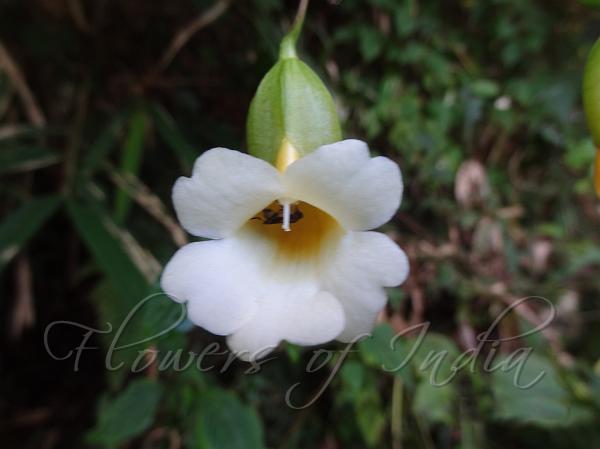|
| Sikkim Clock Vine |
|

|

| File size | 320327 |
| Original date | 9/18/14 12:02 PM |
| Resolution | 2048 x 1536 |
| Flash | Flash did not fire, auto |
| Focal length | 4.28mm |
| Exposure time | 1/50s |
| Aperture | 3.3 |
| Focus Distance | |
| Metering Mode | Multi-segment |
| Camera make | SONY |
| Camera model | DSC-HX9V |
| Sensor type |
|
|
|
|
Photo: |
Botanical name: Thunbergia lutea Family: Acanthaceae (Acanthus family)
Synonyms: Thunbergia salweenensis
Synonyms: Thunbergia salweenensis
Sikkim Clock Vine is a creeper up to 5 m or
longer, climbing. Stems are hairless except for a circle of trichomes
on nodes. Leaf-stalks are 5-7.5 cm, hairless. Leaves are ovate to
lanceshaped-ovate, 4-13 x 2-6 cm, hairless below, pubescent or setose
above, base rounded to broadly wedge-shaped and flat onto the stalk.
Margins are obscurely toothed to sometimes irregularly denticulate, tip
tapering. Flowers are borne in leaf axilsm solitary. Bracteoles are
elliptic, 2.1-2.4 x 1.5-1.7 cm, hairless below, gland-tipped hairy
aboe, palmately 7-veined. Calyx is minute, 10-toothed. Flowers are
pinkish or white; tube basally cylindric for about 7 mm, throat about
3.5 cm, petals circular, about 1.2 cm in diameter, equal. Staminal
filaments are hairless. about 1 cm. Ovary is hairless, style about 2.5
cm, hairless, stigma funnel-shaped, 2-cleft. Capsule is hairless, basal
part about 1 x 1.8 cm, beak about 1.8 cm. Seeds are kideny-shaped,
about 8 x 5 mm. Sikkim Clock Vine is found in Eastern Himalayas, from
Nepal to Sikkim, at altitudes of 1800-2300 m. Flowering:
August-December.
| Identification credit: Sanjyoti Subba | Photographed in Himalayan Zoological Park, Bulbuley, Sikkim. |
• Is this flower misidentified? If yes,